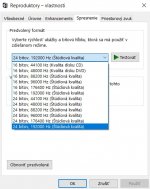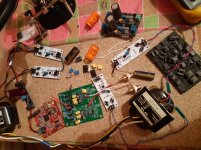Hello everyone. I don’t understand, the DAC is NOS, and it cannot be Hi-Res? Won't Raise Discrimination Using HQPlayer Work?
One can certainly live with two DAC as 99% of the music is 16/44.1. Then many of the Hi-res is not always... high resolution since the recording process. like for instance all the oversampled analog master tapes or the rip from vinyls you can find @R-T 😉
I really think that the said hardness due to interpolation is not so hard on the good NOS DACs... On many recordings you will suffer first of a bad mixing, dynamic compression, loudness war...
One of the best DAC ever can be heard NOS :TOTAL DAC....
good dac chips with a smart layout can certainly give 80% of a Total Dac sound quality :
Ad1862, Ad1865, PCM56, TDA1541A S1/2 or late South Asia years... Modern chips can certainly equal that but at the cost of a great complexity : multiple layers pcb with too much complex design for most of the enthusiasts without HF engineering knowledge and complex tools.
So you really don't care of hi res, just because this is not where the quality stands !
The ad1862 dac chip is 20 bits but can support oversampling though to read 192 K Hz files: be it by a chip before (look at the datasheet of the ad1862) or computer made. Has such process any interest ? No ! Again : very few true High Res recordings to matter. For the 3 and half true 24/192 files you can have, your speakers will distorss before to understand the interrest of such files...
I really think that the said hardness due to interpolation is not so hard on the good NOS DACs... On many recordings you will suffer first of a bad mixing, dynamic compression, loudness war...
One of the best DAC ever can be heard NOS :TOTAL DAC....
good dac chips with a smart layout can certainly give 80% of a Total Dac sound quality :
Ad1862, Ad1865, PCM56, TDA1541A S1/2 or late South Asia years... Modern chips can certainly equal that but at the cost of a great complexity : multiple layers pcb with too much complex design for most of the enthusiasts without HF engineering knowledge and complex tools.
So you really don't care of hi res, just because this is not where the quality stands !
The ad1862 dac chip is 20 bits but can support oversampling though to read 192 K Hz files: be it by a chip before (look at the datasheet of the ad1862) or computer made. Has such process any interest ? No ! Again : very few true High Res recordings to matter. For the 3 and half true 24/192 files you can have, your speakers will distorss before to understand the interrest of such files...
Last edited:
Guys the chip for IC1 to IC6 is obsolete at Mouser. RS in the UK have a MOQ of 50 units. Does Mouser have an alternative?
One can certainly live with two DAC as 99% of the music is 16/44.1. Then many of the Hi-res is not always... high resolution since the recording process. like for instance all the oversampled analog master tapes or the rip from vinyls you can find @R-T 😉
I really think that the said hardness due to interpolation is not so hard on the good NOS DACs... On many recordings you will suffer first of a bad mixing, dynamic compression, loudness war...
One of the best DAC ever can be heard NOS :TOTAL DAC....
good dac chips with a smart layout can certainly give 80% of a Total Dac sound quality :
Ad1862, Ad1865, PCM56, TDA1541A S1/2 or late South Asia years... Modern chips can certainly equal that but at the cost of a great complexity : multiple layers pcb with too much complex design for most of the enthusiasts without HF engineering knowledge and complex tools.
So you really don't care of hi res, just because this is not where the quality stands !
The ad1862 dac chip is 20 bits but can support oversampling though to read 192 K Hz files: be it by a chip before (look at the datasheet of the ad1862) or computer made. Has such process any interest ? No ! Again : very few true High Res recordings to matter. For the 3 and half true 24/192 files you can have, your speakers will distorss before to understand the interrest of such files...
I mean, if I raise 44.100 to 192 20 bits using HQPlayer, the DAC under discussion will receive a signal? So it won't work like a NOS DAC already?
I just got 12 yesterday from Mouser in the US. Part 771-HCT164D652 and they have 34k in stock.
Beginning your pardon there....I copy pasted a part number from this thread and it came up NLA but the number you just gave is obviously good. Thanks for that!
IC1 - IC6
I noticed that Mouser offers two versions of this shift register:
771-74HCT164D-T - Propagation Delay Time:20ns
771-HCT164D652 - Propagation Delay Time:36ns
I don't know anything about shift registers. What is the preferred one for this application? Thanks.
Paddy I will send payment through ASAP for the two DACs.
I noticed that Mouser offers two versions of this shift register:
771-74HCT164D-T - Propagation Delay Time:20ns
771-HCT164D652 - Propagation Delay Time:36ns
I don't know anything about shift registers. What is the preferred one for this application? Thanks.
Paddy I will send payment through ASAP for the two DACs.
I mean, if I raise 44.100 to 192 20 bits using HQPlayer, the DAC under discussion will receive a signal? So it won't work like a NOS DAC already?
Yes. Short response.
I rephrase: You can and it can, but there is no interest in such oversampling process.
You can not create bits & samples that does not exist in the recording.. bits 17 to 20 will be filled with zero, and the up-sampling frequency of a 44.1 or 48 k hz recordings will be not improved by such process. You will have better sound with NOS or close if native in the reccordings , above 96 K Hz sampling rate I'm not sure you can hear a diference. I even really don't hear one between 44 & 88 K hz. Most difference are aware. The slower the crystal the better. Up to you to have or not the USB to I2S player that can read up to 192 K hz (all do that) or even greater up to 384 K hz . Is it usefull in term of SQ ? No, not really seing at the adc chips involved in the reccord process nowadays. (for the rare recordings and studios that makes true Hi res mixing and reccordings...)
Last edited:
I noticed that Mouser offers two versions of this shift register:
771-74HCT164D-T - Propagation Delay Time:20ns
771-HCT164D652 - Propagation Delay Time:36ns
Difference is only in the packaging (Cut tape, Tube). Both have the same Propagation Delay, only a mouser worker wrote it different 😀
You can use 74AHCT164D,118 which is even faster.
I am currently testing if 74HCT164D can handle 192kHz on this DAC, if not then I will test with faster 74AHCT164D.
I am currently testing this DAC on 192kHz with XMOS (standard I2S) and it works flawlessly. 74HCT164D shift registers are installed.
74AHCT164D are even faster, but I have zero experience.
My assumption why RPI doesn't want to play 192kHz on this DAC is, that for 192kHz the I2S word in RPI is shrinked from 64-Bit to 48-Bit by the RPI firmware (this DAC accepts only 64-Bit I2S word). The word is not shrinked on RPI up to 96kHz and stays 64-Bit (I am not sure if on all versions, perhaps the newest does not have this issue). Solution for 192kHz RPI could be driving the AD1862 directly without shift registers using a reclocker with 20-Bit PCM L+R output.
XMOS does not shrink this word for higher frequencies.
All these settings are valid and 24b/192kHz recordings are nicely playable with XMOS
74AHCT164D are even faster, but I have zero experience.
My assumption why RPI doesn't want to play 192kHz on this DAC is, that for 192kHz the I2S word in RPI is shrinked from 64-Bit to 48-Bit by the RPI firmware (this DAC accepts only 64-Bit I2S word). The word is not shrinked on RPI up to 96kHz and stays 64-Bit (I am not sure if on all versions, perhaps the newest does not have this issue). Solution for 192kHz RPI could be driving the AD1862 directly without shift registers using a reclocker with 20-Bit PCM L+R output.
XMOS does not shrink this word for higher frequencies.
All these settings are valid and 24b/192kHz recordings are nicely playable with XMOS

Attachments
Last edited:
As suggested, I tried 1K Ω serial resistor for data and/or BCK instead of 22 Ω.
None worked at 192KHz.
16/24/32 bit has no problem. It is just the KHz that is only good at 96 or below.
My Fifopi u.fl cables to dac are about 90mm long.
Everything is inside a case so length cannot be altered.
I need to Turn on SoX sampling at 24/96KHz to avoid distortion of Hi Res files.
By the way, AD1862 sounds excellent. I wish to try other upgraded opamps in the future.
None worked at 192KHz.
16/24/32 bit has no problem. It is just the KHz that is only good at 96 or below.
My Fifopi u.fl cables to dac are about 90mm long.
Everything is inside a case so length cannot be altered.
I need to Turn on SoX sampling at 24/96KHz to avoid distortion of Hi Res files.
By the way, AD1862 sounds excellent. I wish to try other upgraded opamps in the future.
i can't hear any distortion at 24b/192kHz or 24b/96kHz via XMOS.
Does the Fifopi support 32b/192kHz? (64-Bit I2S word).
Does the Fifopi support 32b/192kHz? (64-Bit I2S word).
Last edited:
Miro1360,
I have 45.X and 49.X clocks installed on Fifopi. Supposedly to be compatible with files up to 384KHz.
I can try RPI4; test moode, Volumio and Rune music apps.
I am using rpi3B and older moode audio app version.
I can also skip Fifopi and make direct I2S connection to RPI4+moode v7.
Thanks for the help.
I have 45.X and 49.X clocks installed on Fifopi. Supposedly to be compatible with files up to 384KHz.
I can try RPI4; test moode, Volumio and Rune music apps.
I am using rpi3B and older moode audio app version.
I can also skip Fifopi and make direct I2S connection to RPI4+moode v7.
Thanks for the help.
The ones using such a dac chip with a Rpi without Fifo and reclocker in between have missed something. We say it again and again : digital front end is as important as the dac chip choice for sounding quality.
Could it be usefull to make a list of I2S streamers able of these 64 bits ? At least the most used ? I.e. Wave I/O, JLSounds I2StoPCM, Amareno, FifoPi and Aloo Kali after a Rpi ?
So Xmos chips are proof ?
I want more to stay NOS anyway or at least up to 20/98 (very few reccordings) with the littliest crystal speed needed for the purpose. 5&6 Mhz or 11&12 Mhz... (I'm forwarding to use SC-Cut clocks of Andrea Mori with this chip as well as my tda1541A daily dac)
Could it be usefull to make a list of I2S streamers able of these 64 bits ? At least the most used ? I.e. Wave I/O, JLSounds I2StoPCM, Amareno, FifoPi and Aloo Kali after a Rpi ?
So Xmos chips are proof ?
I want more to stay NOS anyway or at least up to 20/98 (very few reccordings) with the littliest crystal speed needed for the purpose. 5&6 Mhz or 11&12 Mhz... (I'm forwarding to use SC-Cut clocks of Andrea Mori with this chip as well as my tda1541A daily dac)
PCB v1.3
Ok guys, here is the PCB version 1.3 ... size is the same, function is the same, except:
- more space for bigger audio capacitors
- I2S input has more GND pins for each signal
- C37, C38 is removed from the PCB
Double check it, because this PCB is untested and an editing error may have occurred
Ok guys, here is the PCB version 1.3 ... size is the same, function is the same, except:
- more space for bigger audio capacitors
- I2S input has more GND pins for each signal
- C37, C38 is removed from the PCB
Double check it, because this PCB is untested and an editing error may have occurred

Attachments
-
diyAudio_AD1862_DAC_v1.3_2021-01-10.zip654.8 KB · Views: 166
-
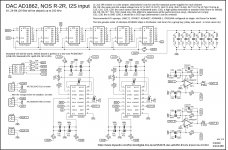 AD1862_Schematic_v1.3.jpg846.6 KB · Views: 760
AD1862_Schematic_v1.3.jpg846.6 KB · Views: 760 -
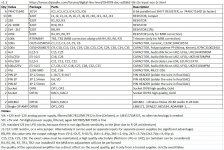 AD1862_BOM_v1.3.jpg453.3 KB · Views: 1,222
AD1862_BOM_v1.3.jpg453.3 KB · Views: 1,222 -
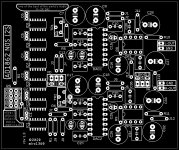 AD1862_PCB_v1.3_PartsView.jpg321.8 KB · Views: 570
AD1862_PCB_v1.3_PartsView.jpg321.8 KB · Views: 570 -
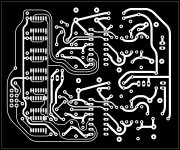 AD1862_PCB_v1.3_TopView.jpg249.5 KB · Views: 551
AD1862_PCB_v1.3_TopView.jpg249.5 KB · Views: 551 -
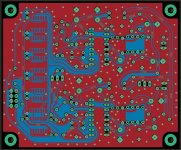 AD1862_PCB_v1.3_TopView2.jpg564.3 KB · Views: 431
AD1862_PCB_v1.3_TopView2.jpg564.3 KB · Views: 431
few ideas
C10 & C19 inversed printing on my v2 , dunno on the v3 🙂
What could be cool is smd pads for 0.1uF 0806 CD FCA caps size with vias in the middle of it for the ones liking radial MKP more ?
keeping both 0.5 mm & 1 mm legs pitch at the same time everywhere for caps ? ... and a little headroom more for the pitch legs for the 1k5 aop resitor ?
ufl pads + vias for the I2S ? with SGSGSG arrengement for the ones using fifoPi or else boards gaving just uf-ls
suppressing 0 ohms straps for the digital signal till the dac chips with using the layers instead ?
Just asking as it s a new year 🙂... going to show my experimenting Miro's version for the porn...
C10 & C19 inversed printing on my v2 , dunno on the v3 🙂
What could be cool is smd pads for 0.1uF 0806 CD FCA caps size with vias in the middle of it for the ones liking radial MKP more ?
keeping both 0.5 mm & 1 mm legs pitch at the same time everywhere for caps ? ... and a little headroom more for the pitch legs for the 1k5 aop resitor ?
ufl pads + vias for the I2S ? with SGSGSG arrengement for the ones using fifoPi or else boards gaving just uf-ls
suppressing 0 ohms straps for the digital signal till the dac chips with using the layers instead ?
Just asking as it s a new year 🙂... going to show my experimenting Miro's version for the porn...
Last edited:
- Home
- Source & Line
- Digital Line Level
- DAC AD1862: Almost THT, I2S input, NOS, R-2R
